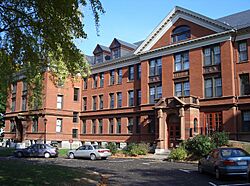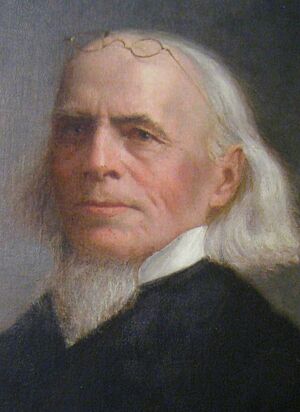Worcester Academy facts for kids
Quick facts for kids Worcester Academy |
|
|---|---|

Dexter Hall
|
|
| Address | |
|
81 Providence Street
, 01604
United States
|
|
| Information | |
| Type | Independent, day and boarding |
| Motto | Ἐφικνοῦ τῶν Καλῶν (Achieve the Honorable) |
| Established | 1834 |
| Head of School | Kevin Breen |
| Faculty | 80 |
| Enrollment | 450 upper school 65 middle school |
| Average class size | 14 |
| Student to teacher ratio | 8:1 |
| Campus size | 71 acres (290,000 m2) |
| Campus type | Urban |
| Color(s) | Maroon |
| Athletics | 24 Interscholastic sports 54 Interscholastic teams |
| Athletics conference | NEPSAC |
| Mascot | Oskee |
| Team name | Hilltoppers |
| Newspaper | Vigornia |
| Yearbook | The Towers |
Worcester Academy is a private school in Worcester, Massachusetts. It's a place where both boys and girls learn together. Students can attend during the day or live at the school as boarding students.
This school teaches students from grades 6 to 12. It is the oldest school founded in Worcester. It's also one of the oldest day and boarding schools in the United States. Worcester Academy helps students get ready for college. It is part of the National Association of Independent Schools.
Contents
The History of Worcester Academy
Worcester Academy started a long time ago in 1834. Its first name was the Worcester County Manual Labor High School. The school changed its name to "Worcester Academy" in 1847.
Isaac Davis was a very important person in the school's early days. He was the President of the school's Trustees from 1834 to 1873.
The school moved to different places when it was first starting. It began on a 60-acre farm. In 1854, the school moved into a building that used to belong to the American Antiquarian Society. This building was on Belmont and Summer streets.
In 1869, Isaac Davis bought an old hospital building. This hospital was on Providence Street. It had been a military hospital during the American Civil War. Davis gave this building to the school. It became the school's new permanent home. The building was named Davis Hall to honor him.
Davis Hall was the only building for Worcester Academy for many years. Sometimes, students even lived there. Davis Hall was damaged by a big hurricane in 1938. It was taken down in 1965. A new building called Davol Hall was built in its place.
Daniel Webster Abercrombie was the principal from 1882 to 1918. He created the school's motto, "Achieve the Honorable," in 1890. During his time, the school grew a lot. New buildings like Kingsley Laboratories (1897) and The Megaron (1905) were added.
Fun Clubs and Teams
Worcester Academy has many interesting clubs and teams. Students can join groups that match their interests.
We the People Club
The "We the People" club is about learning about the U.S. Constitution. In 2010 and 2011, this club won the championship in Massachusetts. They then traveled to Washington, D.C. to compete in the national championship.
Math Team Success
The school's math team is also very strong. In 2011, they won their seventh championship in the Worcester County Mathematics League. They also won their seventh state championship. The team even won their fourth New England championship that year.
Famous People Who Attended Worcester Academy
Many people who became well-known went to Worcester Academy. Some were famous athletes, actors, or leaders.
Here are a few examples:
- H. Jon Benjamin 1984, an actor and comedian.
- Aliyah Boston 2019, a top player in the WNBA basketball league.
- Jim Davis 1962, the chairman of New Balance Athletic Shoe.
- Dane DiLiegro 2007, an actor and professional basketball player.
- Mark Fidrych 1974, a former pitcher for the Detroit Tigers baseball team.
- Gilbert Hovey Grosvenor 1893, who helped start and was the first editor of National Geographic magazine.
- Abbie Hoffman 1955, a social and political activist in the 1960s.
- Tom Holland 1962, a film director.
- Cole Porter 1909, a famous Broadway composer.
- Charles Starrett 1922, an actor known as the "Durango Kid."
- William Toomey 1957, who won a gold medal in the decathlete event at the 1968 Summer Olympics.
Some student-athletes come to Worcester Academy for just their senior year. Or they might come for a special year after high school. They do this to get more attention from college coaches. It also helps them improve their grades.
Here are some notable student-athletes:
- David Ball 2003, who played for the New York Jets in football.
- Colt Brennan 2003, a quarterback for the University of Hawaii.
- Rick Carlisle 1979, a former NBA player and coach. He coached the Dallas Mavericks to an NBA championship in 2011. He is currently the coach of the Indiana Pacers.
- Jarrett Jack 2002, who played for the Brooklyn Nets in the NBA.
- Michael Malone 1989, the Head coach of the Denver Nuggets basketball team.
- Joe Philbin 1980, a former head coach for the Miami Dolphins football team.
- Craig Smith, a former NBA player.
Leaders of Worcester Academy
The school has had many leaders, called Headmasters or Heads of School, over the years. Here is a list of all of them:
| Number | Name | Years |
|---|---|---|
| 1st | Silas Bailey, D.D. | 1834–1838 |
| 2nd | Samuel Stillman Greene, LL.D. | 1838–1840 |
| 3rd | Nelson Wheeler, A.M. | 1840–1847 |
| 4th | Eli Thayer 1840, A.M. | 1847–1849 |
| 5th | Charles C. Burnett, A.M. | 1849–1852 |
| 6th | Eleazer J. Avery, A.M. | 1852–1854 |
| 7th | William S. Greene, A.M. | 1854–1858 |
| 8th | Werden Reynolds, A.M. | 1858–1860 |
| 9th | James R. Stone, D.D. | 1860–1862 |
| 10th | Ambrose P. S. Stuart, A.M. | 1862–1864 |
| 11th | Charles Ayer, A.B. | 1865–1866 |
| 12th | Albert Prescott Marble, PhD | 1866–1868 |
| 13th | William C. Poland, A.B. | 1868–1870 |
| 14th | Willard T. Leonard, M.A. | 1870 |
| 15th | Rev. David Weston, A.B. | 1870–1871 |
| 16th | John D. Smith, A.B. | 1872–1875 |
| 17th | Nathan Leavenworth, A.M. | 1875–1882 |
| 18th | Daniel Abercrombie, Litt.D., LL.D. | 1882–1918 |
| 19th | Samuel Foss Holmes, A.M. | 1918–1933 |
| 20th | Harold H. Wade | 1933–1942 |
| 21st | LeRoy A. Campbell, PhD | 1942–1950 |
| 22nd | Paul K. Phillips, A.B. | 1950–1954 |
| 23rd | William S. Piper, Jr., Ed.D. | 1954–1968 |
| 24th | Harold G. Rader, Ed.D. | 1968–1969 |
| 25th | David R. Jefferson, B.A., B.D. | 1969–1970 |
| 26th | Robert A. LaBranche 1946, M.S. | 1970–1974 |
| 27th | John A. Bloom, M.A. | 1974–1985 |
| 28th | Ben Williams, M.A. | 1985–1991 |
| 29th | John Mackenzie, M.A. | 1991–1997 |
| 30th | Dexter P. Morse, M Ed., C.A.G.S. | 1997–2012 |
| 31st | Ronald M. Cino | 2012–2021 |
| 32nd | Kevin Breen | 2021–Present |
More Information



